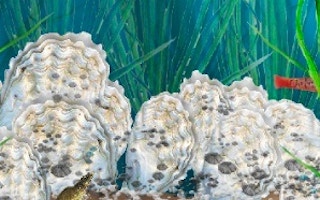Decades ago, few countries appeared to be affected by Harmful Algal Blooms (HABs), but now most coastal countries are threatened. These blooms form massive blankets of slime on the water’s surface that precipitate bacteria growth, deplete oxygen, and kill much of the life in the water below. The causes of HABs destructive global expansion are debated, with plausible explanations ranging from natural mechanisms of species dispersal to a host of human-related phenomena such as pollution in the form of nitrogen and phosphorus.
The Arabian Gulf is plagued by HABs that threaten approximately 1,500 desalination plants, which provide an estimated 60 per cent of the drinking water for the region. The demand for fresh water is continually increasing in the Arab Gulf Region due to population and industry growth, coupled with higher standards of living. Desalination and power plants, which use seawater for cooling, are forced to close during HABs outbreaks to avoid the fouling and blockage problems. HABs are emerging as a serious problem threatening public health, coastal fisheries, industry, marine aquaculture and tourism for the region.
HABs occurrences in the Arabian Gulf during 2006 and 2008 caused considerable environmental damage and economic loses; and there are predictions that this phenomenon will occur more frequently in the future. Early in 2009 and throughout the year, there were more inimical HABs incidents with the UAE coastline suffering the most damage. The Abu Dhabi Water & Electricity Authority conducted research and determined the species responsible is called cocklodinium polykrikoides. Its destructive presence was attributed to anthropogenic nutrient loading coupled with the dynamics of climate change.
No single organism can be blamed for the HABs damage infecting the entire Arabian Gulf Region. However, some are more culpable, and many of the species are regional and quite adaptive. The two principal types of toxic HABs are: phytoplankton producing mostly chemical toxins harmful to fisheries and the environment; and, dinoflagellates that produce neurotoxins harmful to humans and marine mammals. Both are associated with eutrophication, which is the over-enrichment of an ecosystem with chemical nutrients such nitrogen and phosphorus.
Ecosystem services from bivalve shellfish
The general public is unaware that beds of bivalve shellfish provide ecosystem services by naturally filtering nutrients from the water. Bivalve shellfish are filter feeders that remove suspended solids from surrounding waters, thereby increasing water clarity, enabling seagrass growth and reducing the likelihood of HABs. Bivalve shellfish were once the global ecosystem engineers and enablers of prosperous habitats for other species.
The Gulf Pearl Oyster (lulu or locally called qamashah) provided a source of local wealth to the Gulf Region long before the discovery of oil. Known to scientists as (pinctada radiata) this large bivalve can tolerate a wide temperature range (13-30 C) and is found attached to rocks in depths of between 5 and 25 metres. It is also known for its ability to adapt and breed in subtropical environments and to survive in polluted water. This native oyster is currently cultured for pearls in Qatari waters and harvested for its edible flesh and lustrous shell on a limited basis.
But like many shellfish species across the globe, the Gulf Pearl Oyster has lost its dominant role as a ecosystem engineer. The Nature Conservancy recently released its Shellfish Reefs at Risk report, which states: “Centuries of intensive fisheries extraction, exacerbated by more recent coastal degradation, have put oyster reefs near or past the point of functional extinction worldwide. Globally, 85 per cent of reefs have been lost, making oyster reefs the most severely impacted marine habitat on the planet”. Could there be a correlation between the decrease of shellfish reefs with the increase in global HABs?
Scientists claim that bacteria in sediment around oyster beds biologically remove at least 20 per cent of the nitrogen in wastes through the same process used in modern wastewater treatment plants. While most of the nutrients filtered from the water by oysters are recycled back into the water column, the flux of undigested plant matter into the sediments stimulates bacterial processes known as nitrification and denitrification. This process of turning fertilizer ammonia into nitrate and then into harmless nitrogen gas allows its escape into the atmosphere instead of stimulating phytoplankton blooms. These findings suggest that if large oyster populations could be restored, these beds could play an important role in helping to achieve nitrogen reductions for mitigating HABs in the Arabian Gulf.
Incredibly, an adult oyster can filter up to 50 gallons of water a day, allowing sunlight to penetrate so that foundations of the food chain can thrive; once water clarity increases, bottom vegetations, such as eelgrass, flourish. Scientists have calculated that enormous oyster beds in the United States’ largest estuary, the Chesapeake Bay, could once filter its entire volume of water (about 19 trillion gallons) in a week. Today, it would take the nearly decimated remaining bay oysters more than a year.
Arabian Gulf flushing times are estimated to be up to five years. Since dense beds of shellfish would promote denitrification to augment expensive wastewater treatment technologies, what would be the economic return of a massive oyster restoration program for the Arabian Gulf?
Shellfish harvest for the Arabian Gulf Market
The Gulf Cooperation Council (GCC) and Middle East countries are seeking alternative methods to reduce dependence on the rest of the world for 90 per cent of their food needs. One of those methods involves investing millions of dollars to improve agriculture feeds for a rapidly expanding poultry industry to feed the future population.
Shellfish contain the essential amino acids required for poultry feed and could offer a sustainable replacement for fish meal, which has spiked to $1,700 a metric tonne in past few years. A pilot project in Sweden is producing 20 tonnes of mussel meal from the Baltic Sea to compete with fishmeal on the organic feed market.
Furthermore, there are millions of expats residing in the Arabian Gulf Region who culturally crave the consumption of shellfish. Consider also that the Dubai Airport will have capacity for 80 million passengers in 2012 and many will be Asians willing to pay a premium for fresh shellfish.
From a “harvest” perspective, sustainable cultivation of shellfish in the Arabian Gulf could provide food security for local human consumption, feed stocks for an emerging poultry industry, and exports for diversifying an oil-based economy.
From a “habitat” perspective, restoring the Gulf Pearl Oyster as a cornerstone species makes sense on its merits since oysters ecologically serve as indicators of overall health and also provide habitat for attracting fish, crustaceans, and other marine life. Such a program may also prove to be a promising proposition for mitigating HABs in the Arabian Gulf.
Phil Cruver is President of KZO Education, a nonprofit organization that conducts education and research for shellfish ecosystem services.









